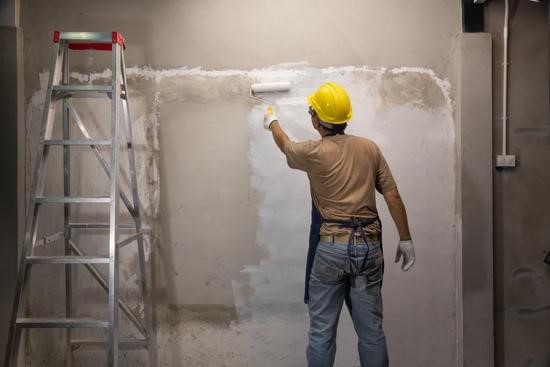If we look around in the interior design industry, accent walls have become a popular trend. You can notice them everywhere, from your relatives’ living room to your favorite local café, you can notice one beautifully articulated accent wall. These walls present more than just a trendy statement, they are an affordable, easy, and impactful way to add visual appeal to any room. So, how to paint an accent wall?
Keep on reading this article to understand all the do’s and don’ts of painting an accent wall for your room or living room.
Table of Contents
6 Essential Steps to Paint an Accent Wall
If you want to add an accent wall to your living room, go through the step-by-step instructions below:
1. Decide Where You Want the Accent Wall
Accent walls have a certain charm. However, that doesn’t make it mandatory to put them in every nook and corner of your house.
Having more than one accent wall may feel overwhelming. That’s why you should decide the room where an accent wall will look the best. Consider the room with a splash of color and a consolidated palette.
After deciding on the room, pick the right wall. It’s the one that generally grabs attention when you enter a room, and it’s a natural focal point.
For example, painting the wall around a fireplace can make it even more dramatic. In a bedroom, the wall behind the headboard is the most attractive. The luxurious sofas and gallery walls can have an accent wall that serves as a stunning backdrop.

2. Figure Out the Scope of Your Design
If you only plan to paint an accent wall to bring a change to your room, your job is fairly simple.
However, if you look to redesign the room completely, ensure to plan out everything before proceeding. For example, if you want to change your decor or furniture colors, you should pick the accent wall color after deciding on the room palette.
3. Determine the Best Color for the Accent Wall
Although it’s not a labor-intensive step, picking the right hue for your accent wall can be the most difficult one.
We recommend following the below-mentioned rule to choose a color for the accent wall:
- Dominant color covers 60% of the room
- The secondary color covers 30% of the room
- Accent color covers only 10% of the room
As the name implies, the accent wall should be an accent color in the overall scheme of your room. Accent colors are supposed to be bright or bold hues that will help contrast dramatically with other colors in the room.
After picking a general color, select 2-3 specific hues to test. Paint about 1 square foot of the wall in each color on the accent wall-to-be. Observe all the colors in different lighting at different times to decide which looks best.
4. Prepare the Room for Painting
While you prepare to paint the wall, plan for the room to stay unusable for a few days. Mostly, you will need to remove everything from the room. However, if you have to keep the furniture in the room, move it at least five feet away from the accent wall you will paint. It will allow you to move around the room. Moreover, cover the furniture to save it from spills or drips.
Remove all the decor items from accent walls. Once you have cleared the room and moved all furniture out of the way, you can begin preparing the wall.
The first step is to clean the wall using water and mild soap. Use a non-abrasive sponge or rag to wash the wall. You can use the rag to remove any dust or dirt as well. If there are old paint stains, don’t worry about them, because they will get covered with paint. However, you don’t want any debris getting stuck in the new paint.
The next step is to ensure the wall is smooth and has no holes. If there are small-sized holes, you can use a pocket-sized spackle pan to fill them. It’s relatively easy and will save you from any trouble down the road.
To fill large holes, ensure the repair texture matches the rest of the walls.
5. Apply Painter’s Tape
No matter how carefully you do a paint job, the paint can end up in places it’s not supposed to be.
Before painting, use high-quality painter’s tape to tape the wall edges along the sides, the ceiling, and the floor.
Tape off all other features you don’t want to be painted, such as window frames or fireplaces. Now, take a plastic drop cloth to put on the floor to protect it from paint spills.
6. Paint the Accent Wall
It’s finally time to paint the accent wall. If the wall is stained or you are switching from a dark color to a light tone, you may want to add a coat of primer before painting. It will ensure better coverage of the paint.
Start the painting by cutting in along the corners with a paintbrush because rollers hardly work in the corners. Afterward, use the paint roller at the top of the wall and move downward, painting in a smooth W motion.
You will notice that a roller is easier to use than brushing the entire wall. It keeps your color even, but you should keep the paintbrushes at hand for quick touch-ups.

Many paints need two coats for complete and even coverage. Keep the painter’s coat up for each coat to maintain a clean line.
Once the final coat gets dry, remove the painter’s tape. Give the room at least 1-2 days to dry. This period also depends upon the thickness of the paint coat.
After the paint is fully dry, check the wall to see if you need to do any touch-ups.
Enjoy Your New Accent Wall!
Once your newly painted accent wall is completely dry, put the room back together. Move the furniture to its original place and put back all the decor items.
You may want to change some of your existing decor items to match with the new accent wall. Rearrange the items as you see fit, and enjoy your room’s new and fresh appearance.





